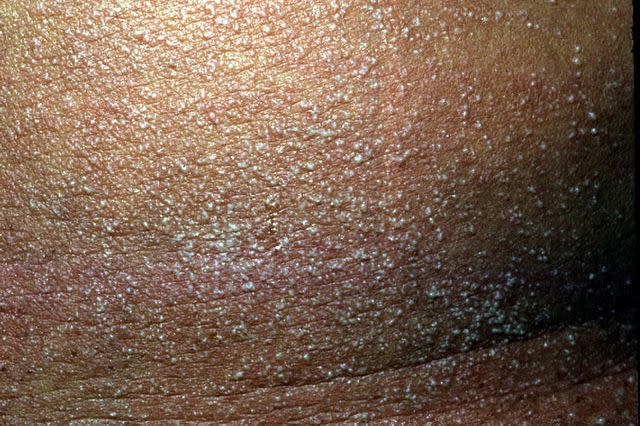What a Heat Rash Looks Like on Darker Skin (and What to Do Next)
Medically reviewed by Brendan Camp, MD
Heat rash, also known as prickly heat or sweat rash, is a common name for a skin condition called miliaria. This is a rash that develops when the sweat glands become blocked. The rash can vary in appearance based on a person's skin tone.
This article will discuss what a heat rash looks like on dark skin tones, treatment options, and when to contact a healthcare provider.

AndreyPopov / Getty Images
Why Does Rash Appearance Vary With Skin Tone?
A 2021 article in The Pharmaceutical Journal discussed how medical textbooks and training have historically focused on the appearance of skin conditions in those with light skin. This has led to healthcare providers having difficulty providing accurate diagnoses and prompt treatment for those with dark skin.
A rash's appearance will vary significantly based on a person's skin color. This is partly due to the different amounts of melanin in the skin. Melanin is the substance that gives skin and hair its color. When someone has darker skin, there may be less of a color contrast between the skin affected by the rash and the healthy skin.
An example is how erythema (redness of the skin) on light skin looks red. However, darker skin can have a purple hue, ashen gray, or darker brown appearance.
What Does a Heat Rash Look Like on Dark Skin Tones?

Reproduced with permission from ?DermNet www.dermnetnz.org 2023
Heat rash can appear as small, raised bumps that look like pimples. These bumps form in clusters and can easily break. The bumps can look white or darker than the surrounding skin in people with dark skin tones.
Common Signs of a Heat Rash
Heat rash is a skin condition created by blocked eccrine sweat glands, the main sweat glands of the human body.
When your body temperature rises, you will release sweat through these glands. As the moisture rises to the skin's surface, it will evaporate, causing the body to cool down. However, when the sweat glands are blocked because of clothes, skinfolds, or other means, sweat gets trapped beneath the skin. This causes inflammation, which leads to a heat rash.
Common signs of a heat rash are:
Small, itchy bumps
On dark skin, bumps that appear darker than the surrounding skin
On light skin, bumps that appear red
These small bumps can resemble pimples and are clear blisters. They are commonly found on the head, upper trunk, and neck.
How Is a Heat Rash Diagnosed?
Heat rash is diagnosed based on its appearance. A healthcare provider may ask questions about recent heat exposures or heat rash history. They will then examine the rash and if they are unable to confidently determine if it is a heat rash, they may perform a skin biopsy (removing a sample of skin for analysis in a lab).
What Else Could Be Mistaken for a Heat Rash on Dark Skin?
Skin conditions that cause small, pimple-like bumps may be mistaken for a heat rash on dark skin. These include:
Toxic erythema of the newborn
Many times it's the context of the rash that helps a person identify its cause. Understanding that heat rashes are caused by warm weather and blocked sweat glands can help eliminate other rash sources and narrow down possible rash causes.
How Long Does a Heat Rash Last?
Generally, a heat rash lasts one to two days after the body has cooled down. More severe forms of the rash can last for a week or longer.
How Is a Heat Rash Treated?
Heat rash can usually be treated at home with a few steps. The first step is to reduce the body's temperature. Get out of the heat and dry off the skin. Then take a cool shower or apply cold compresses to the skin affected by heat rash.
Heat rash can be very itchy. Over-the-counter (OTC) anti-itch products like hydrocortisone cream or calamine lotion can minimize itching. Do not use skin products that can block the sweat glands, like sunscreen, oily moisturizers, or baby powder.
To prevent heat rash, avoid wearing synthetic fabrics that trap the heat. Clothing should be loose-fitting to allow airflow. Also, make sure to take frequent breaks during warm weather to avoid overheating.
When to Contact a Healthcare Provider
If the heat rash has not improved after one week or is extremely painful it is time to contact a healthcare provider.
A secondary bacterial infection, frequently from the Staphylococcus bacterium, is a potential complication of heat rash. Any time there are signs of an infection (redness, swelling, warmth, pain, and drainage), a healthcare provider should be consulted.
Summary
Heat rash is a skin condition that causes an itchy, bumpy rash. People who have dark skin may present with darkened areas with small white or dark-colored bumps. Blocked sweat glands cause the rash. It generally resolves within one or two days.
In more severe cases it can last up to a week. If the rash lasts longer than a week, is accompanied by severe pain, or appears infected then contact a healthcare provider.
Read the original article on Verywell Health.
